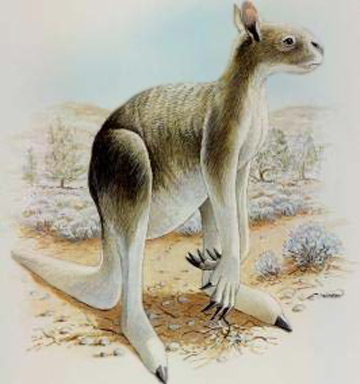
|
Search JoyZine with Google Site Search! |
Giant Wallaby Protemnodon
Protemnodon is a genus of megafaunal macropods that existed in Tasmania and Papua New Guinea in the Pleistocene. Based on fossil evidence it is thought that Protemnodon was physically similar to wallabies but far larger; Protemnodon hopei was the smallest in the genus weighing about 45kg, the other species all weighed over 110kg. More than 40,000 years ago, megafauna like Protemnodon anak, an animal physically similar to a wallaby that weighed more than 110kg, roamed Tasmania. Researchers long believed that these creatures died out before humans were able to cross from the Australian mainland into Tasmania, when a land bridge briefly connected the two across the Bass Strait. Since humans were not believed to have had any contact with these megafauna, the most popular belief was that environmental factors stemming from climate change led to their extinction. However, new research from the Australian Nuclear Science and Technology Organisation (ANSTO) suggests that humans and giant wallabies may well have co-existed for 2,000 years. Previous attempts at dating the remains of these prehistoric ancestors of the kangaroo, wombat, and Tasmanian devil involved radiocarbon dating the mineral fractions found in their bones. These indicated that the last of the megafauna died off before the earliest archaeological charcoal — indicating the presence of humans — found on Tasmania. Dating the mineral fractions, however, may not offer the most accurate data since elemental exposure can contaminate those fractions. ANSTO has been rethinking their dating techniques and opted instead to radiocarbon date the protein fractions in the bones. Those dates indicate that megafauna overlapped with humans for a significant amount of time. So, if that data is correct, humans did set eyes on these giant mammals, and perhaps hunted them as well. ANSTO has not yet found evidence of Tasmanian human-megafauna interaction, but this may offer a clue in a millennia-old cold case. |
